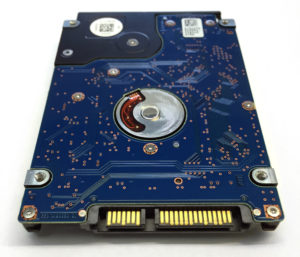Hard disk drives (HDDs) are typically categorized by their interface or by the technology used to store data. In this article, we’ll provide a brief definition of each “type” of hard drive and how categorization plays a role in the data recovery process.
First, here’s a quick list of every HDD category.
Hard Drive Interfaces:
- Storage Module Device (SMD)
- Enhanced Small Disk Interface (ESDI)
- Shugart Associates System Interface (SASI)
- Small Computer System Interface (SCSI)
- Parallel AT Attachment (PATA), also known as IDE/EIDE
- Serial AT Attachment (SATA)
- Serial-Attached SCSI (SAS)
Hard Drive Technologies:
- Heat-Assisted Magnetic Recording (HAMR)
- Shingled Magnetic Recording (SMR)
- Helium Hard Drives
For the purposes of this article, we won’t be discussing SMD, SASI, or ESDI in detail — those interfaces, while historically important, are nearly 100% obsolete.
If you need data recovery services for any type of hard drive, we’re here to help. Datarecovery.com provides risk-free evaluations, and all of our hard drive data recovery services feature a no data, no charge guarantee: If we’re unable to identify the files you need, there’s no charge for the attempt. Call 1-800-237-4200 to learn more or submit a case online.
Hard Drive Interfaces
A hard drive interface is the bus that allows the drive to communicate with your computer. Most modern computers use SATA, but various other standards have been utilized over the past several decades.
SATA (Serial AT Attachment)

A laptop hard drive with a SATA connection.
The current standards for personal computing hard drives and solid-state drives is SATA, maintained by the Serial ATA International Organization (SATA-IO). If you’re wondering where the “AT” in “Serial AT Attachment” comes from, it’s a reference to the IBM Personal Computer AT, a 1984 computer that established early standards for hard disk drives.
SATA communicates data over two pairs of conductors, which allows for smaller cables and faster transfer speeds than earlier standards. SATA III, the modern standard, allows for a max throughput of 600 megabytes per second (MB/s).
PATA IDE (Parallel AT Attachment Integrated Electronics) and EIDE
Introduced in 1986 by Compaq and Western Digital, these interfaces utilize parallel signaling technology to achieve data transfer rates as fast as 133 MB/s. Slight changes to the standards created some confusion regarding terminology: Drives with PATA interfaces may also be referred to as EIDE or IDE.
If your computer is more than 20 years old, there’s a good chance that it utilizes PATA (and if that’s the case, it’s past time for an upgrade!). Otherwise, you can assume that you’re using SATA: By 1998, SATA had replaced about 99% of PATA’s market share.
Parallel SCSI (Small Computer System Interface)
Introduced in the 1980s, SCSI standards have been revised regularly over the past three decades. They allowed for connection with a variety of peripheral devices (such as printers), with relatively high data transfer rates of up to 320 megabytes per second (MB/s) — fairly powerful for the 1980s, but not especially fast by modern standards.
Today, SCSI is rarely used for home computer systems, as USB provides better functionality for peripheral devices. SCSI is still found in some older RAID systems, but enterprise applications have largely replaced SCSI with Serial Attached SCSI (SAS), discussed below.
SAS (Serial Attached SCSI)
Serial Attached SCSI (SAS) is a high-performance serial interface for connecting storage devices to computers, and it was introduced in 2003 as a replacement for parallel SCSI.
SAS offers several advantages over Parallel SCSI, including higher data transfer speeds, longer cable lengths (important for enterprise applications), and support for a greater variety of devices. Currently, SAS has a maximum transfer speed of 12 gigabits per second (about 12,000 MB/s).
Hard Drive Technologies
While interfaces are the most common metric for hard drive categorization, enterprise-level hard drives may be identified by the technologies used to increase their areal densities (the amount of data that can be stored in a given physical area).
Important hard drive technologies include:
- Heat-Assisted Magnetic Recording (HAMR), which uses a laser to heat up the magnetic material on the platters, allowing for greater precision at high areal densities.
- Shingled Magnetic Recording, which overlaps data tracks to allow for narrower tracks (and greater areal densities).
- Helium drives, which use helium (or another gas) in an airtight enclosure to allow for faster speeds, cooler operation, and less noise with lower power requirements.
Is a solid-state drive a type of hard drive?
 While solid-state drives (SSDs) serve the exact same function as an HDD, they use a fundamentally different technology. SSDs are not magnetic storage devices — they store data electronically, and they do not require moving parts.
While solid-state drives (SSDs) serve the exact same function as an HDD, they use a fundamentally different technology. SSDs are not magnetic storage devices — they store data electronically, and they do not require moving parts.
As such, SSDs are not hard drives. They are not referred to as hard drives within the data recovery industry; they’re storage devices, but closer in design to a flash memory stick than an HDD.
Related: How Do Solid State Drives Store Data?
Does the type of hard drive affect the chances of data recovery?
Your hard drive’s interface should not affect your chances of a successful data recovery — provided that your data recovery provider has fully equipped laboratories that can handle the case. This is particularly important for older drives with atypical interfaces (such as PATA drives).
Datarecovery.com maintains laboratories at every location, and our extensive hard drive parts inventory ensures best-in-industry turnaround times and recovery success rates. To learn more, get started with a free evaluation or call 1-800-237-4200 to speak with an expert.





